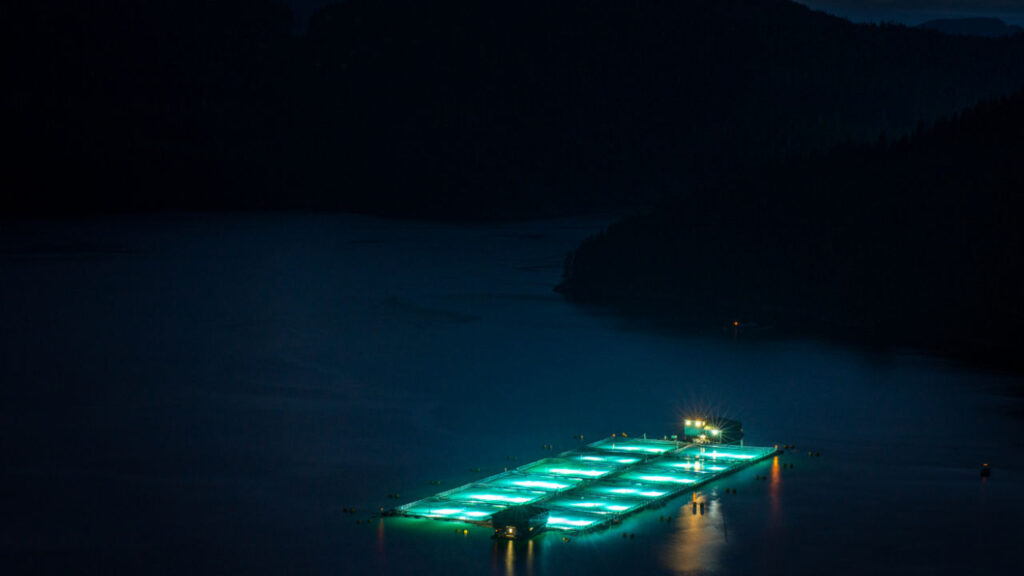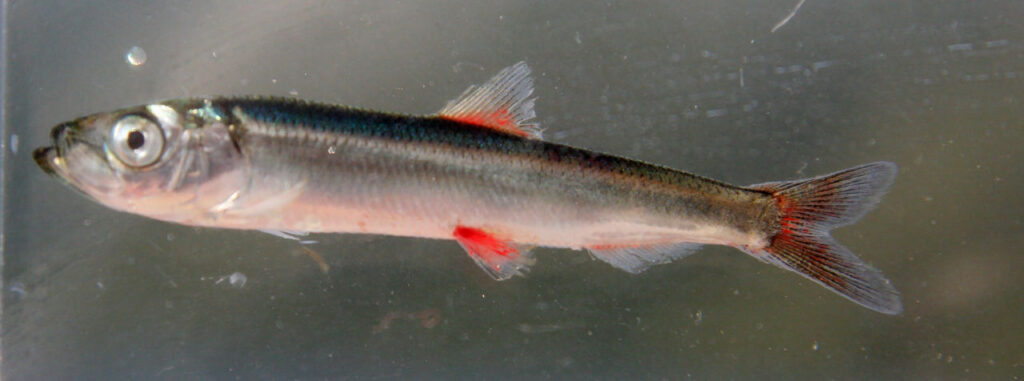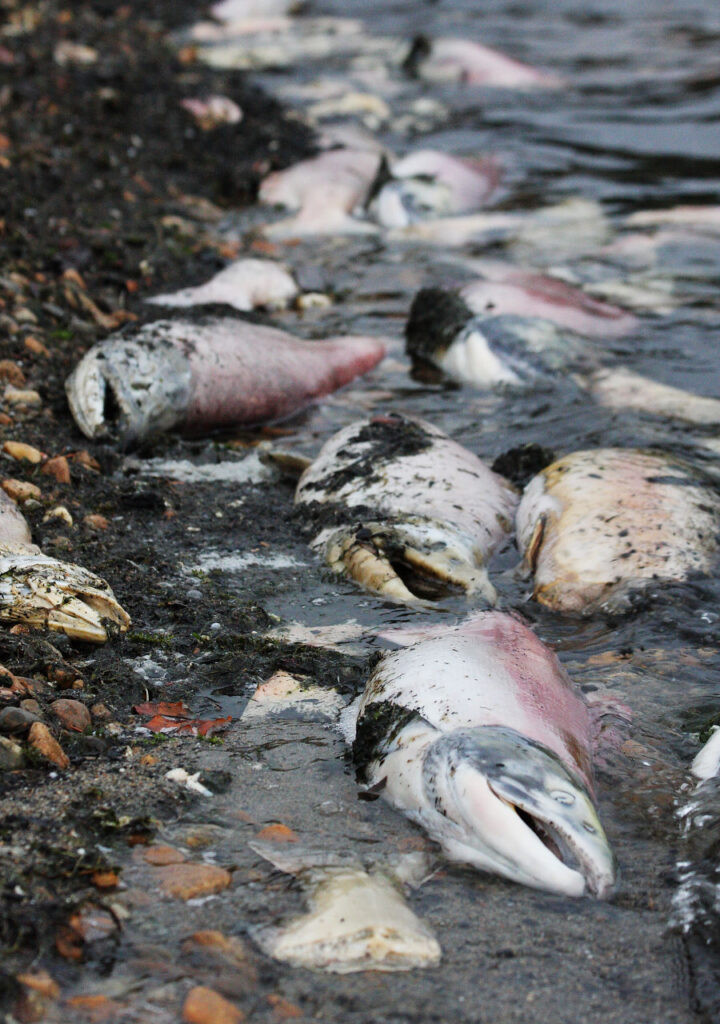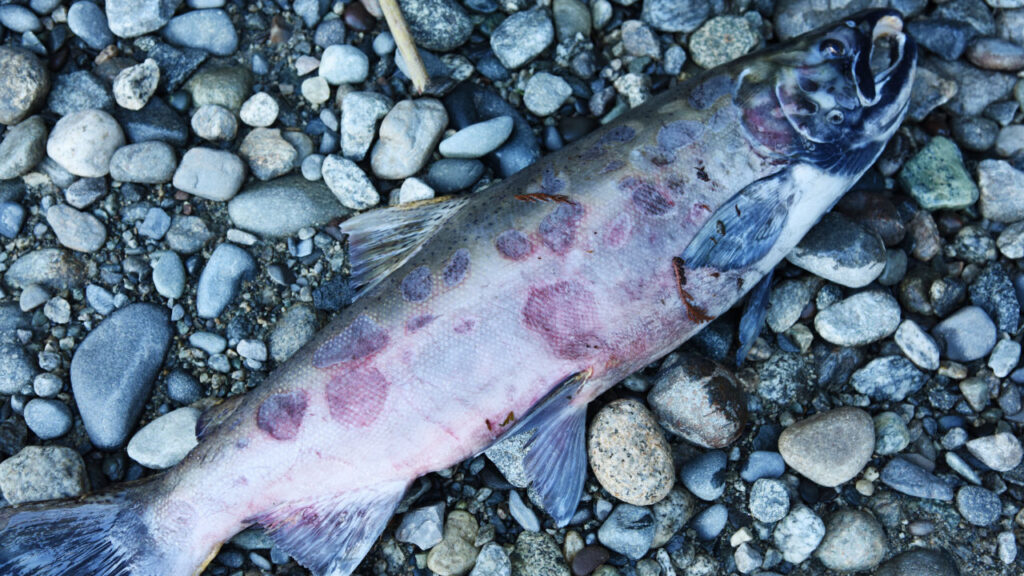

“I thought I was making a film about the collapse of wild salmon on the Pacific Coast of Canada which was bad enough. But my investigation led me to a much bigger story. A story that included the collapse of all fin fish in the northern hemisphere, the debunking of old truths and a scary link to our climate crisis.”
Director, Scott Renyard
Disturbing Scenes – Fish Farm Impacts – Global Warming – Investigative
Introduction
The marine ecosystem off the coast of British Columbia is collapsing. In the late 1990’s, Alexandra Morton, a whale biologist who lives in the Broughton Archepelago, began to document the decline of pink and chum salmon in her area. At the time, I was an avid sport fisherman. I spent many days on the Vedder River fishing for salmon. One day, I noticed dozens of silver bright salmon floating belly up in the river. I was angry at, what I thought, other anglers for mishandling fish. But then I heard about Morton’s observation that sea lice from fish farms were impacting the pink and chum runs in her area. I called her and asked if she thought those impacts could be reaching the fish populations in my area. She didn’t know, but it was a moment for both of us to ponder that this issue might be much more widespread.
I decided to make the issue the subject of my next film. But I found out two other film makers were already on the story. I began interviewing subjects looking for a fresh way into the story. Finally, in the spring of 2010, Alexandra planned a protest walk from the tip of Vancouver Island to the provincial capital, Victoria. The protest was dubbed the “Get Out Migration” as a call to action for the fish farms to get out of the way of wild salmon migration. The protest started off with just a handful of supporters. But by the time she got to Victoria thousands of people joined her on the lawn of the provincial legislature.

A Turning Point
One day Morton handed me a photo of a herring and it was sick and bleeding from its eyes and fins. This photo became part of the film’s poster. It was a major turning point in my understanding of the issue. Until that moment, I thought I was going to make a film about declining wild salmon populations and the ground swell of public support behind Morton’s opposition to open net pen fish farming. Fish farms affecting wild salmon was certainly a big topic, but this photo made this story much, much bigger.
I began to dig through hundreds of documents, reading old newspaper articles, and reviewing data about wild fish populations on both the east and west coast of Canada. Some of those documents included old internal government memos from bureaucrats warning about importing exotic diseases from Europe. They warned politicians that if we import live biological material like fish eggs, we will also import exotic diseases. One bureaucrat said that we were playing Russian roulette with our wild salmon. Those predictions came true. What they didn’t anticipate was those diseases affecting wild salmon would also infect other species of fish.

The Sea Lice Problem
I stitched together key milestones of the fish farm industry and interviewed an early fish farmer. It was clear from its earliest days the industry was having difficulties with disease. Fish farm operations were plagued with sudden mass die-offs. A key part of this struggle is to control sea lice populations. Sea lice can, on their own, kill juvenile fish simply by chewing on them. But sea lice also carry viruses and bacteria from fish to fish. This means that thousands of farmed fish packed into small pens provide ideal conditions for sea lice populations to grow out of control.
But that’s not all. If sea lice populations explode, so do the diseases that sea lice carry. Sea lice are known vectors which means they can carry viruses and bacteria from host to host. And with many more sea lice, there are many more opportunities to them to infect other hosts. So why don’t fish farms use a closed system to protect their fish?
Open Net Pen Farms
The open net pen farm was designed to encourage interactions with the wild environment. So, fish farms benefit from the free disposal of waste to the bottom of the ocean by flushing and by grazing on wild juvenile fish and organisms to off set food costs. However, this also means fish farms can’t stop sea lice or diseases from entering the farms from the wild. Fish farms add more fuel to this problem because they transfer live material around the world from one operation to another. This ensures that diseases that were once isolated to certain regions are now, in many cases, world wide.
One disease I feature in the film is Viral Hemorrhagic Septicemia or VHS. This disease has now been spread far and wide and can infect many fin fish. VHS causes population crashes approaching 100% when a new fish population is exposed to the virus. One 1987 study, led by DFO scientist John D. Neilson, entitled Interactions of caligid ectoparasites and juvenile gadids on Georges Bank collected some surprising data off the east coast of Canada.
The authors noticed a dramatic decline in the numbers of juvenile fish larvae and huge increases in sea lice. The theory, at the time, was thermoclines in the water skewed the study’s results. But fish farms had recently been introduced to the area. And there has been enough studies to show that where ever fish farms are placed, sea lice plagues follow. Clearly, the conclusions of the study might have been very different if the data was evaluated with this knowledge in hand.




Marine Food Web Impacts
This shift in the marine food web occurred in the mid 1980’s. I conclude that the decline of wild fish populations on both of Canada’s coasts are not from overfishing or climate change, but from disease.
Once I had reached these conclusions, I thought the film was done. But, one morning I read a newspaper article about PhD candidate, Dr Trisha Atwood, at the University of British Columbia. Her study sent a chill up my spine. She had discovered that by removing predators from an aquatic ecosystem, carbon dioxide emissions increased by 93%. Her findings confirmed that the loss of predators would cause a tropic cascade that would lead to lower phytoplankton populations. This would lead to an overgrazing of phytoplankton by the zooplankton that would have been eaten by the predators. And in a marine ecosystem, fish are key predators.
The Link to Climate Change
I interviewed Dr Atwood and Dr Pieter Tans from NOAA about importance of the marine food chain in the carbon cycle. From this information, I realized that the loss of wild fish populations could have a major impact on atmospheric carbon dioxide levels. And, therefore, aquaculture may turn out to be as important to the global warming issue as the burning of fossil fuels. Marine fish farming might turn out to be the largest contributor to atmospheric greenhouse gases of all human activities.
- Scott Renyard Writer, Director, Producer
- Maja Zdanowski Editor
- Mark Noda Director of Photography
- Stu Goldberg Composer
- Kirby Morrow Narrator
- Phil Johnston Production Designer
- Richard Hagensen Title song
- Joanne Banks Title song
- Sarad Renyard Logo music
- Harold Donnelly Logo music
Appearances by
Alexandra Morton, Dr. John Volpe, Rafe Mair, John Allen Fraser QC, Grand Chief Stewart Phillip, Joan Phillip, Chief Darren Blaney, Bartlett Naylor, Dr. Craig Orr, Marty Krkosek, Don Staniford, Billy Proctor, John Cummins, Geoff Meggs, Dr. Trisha Atwood, Dr. Peter Pearse, Brad Hope, June Hope, Dr. Pieter Tans, Dr. Daniel Pauly, Otto Langer, Greg McDade QC, Franscois Perrault, Ian Gill